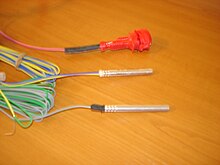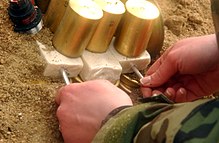
Back كبسولة التفجير Arabic Дэтанатар Byelorussian Детонатор Bulgarian Detonador Catalan Detonator Danish Sprengzünder German Πυροκροτητής Greek Prajmo Esperanto Detonador Spanish Detonaator Estonian
This article has multiple issues. Please help improve it or discuss these issues on the talk page. (Learn how and when to remove these template messages)
|


A detonator, sometimes called a blasting cap in the US, is a small sensitive device used to provoke a larger, more powerful but relatively insensitive secondary explosive of an explosive device used in commercial mining, excavation, demolition, etc.
Detonators come in a variety of types, depending on the way they are initiated (chemically, mechanically, or electrically) and details of their inner working, which often involve several stages. They include non-electric caps, electric caps, and fuse caps, the last two being the most common. Electric types are set off by a short burst of current sent to the cap, by a blasting machine via a long wire or a radio controlled source to ensure safety. Traditional fuse caps have a fuse which is ignited by a flame source, such as a match or a lighter.
Old detonators used mercury fulminate as the primary explosive, often mixed with potassium chlorate to yield better performance. This compound was superseded by others: lead azide, lead styphnate, some aluminium, or other materials such as DDNP (diazo dinitro phenol) to reduce the amount of lead emitted into the atmosphere by mining and quarrying operations. They also often use a small amount of TNT or tetryl in military detonators and PETN in commercial detonators.